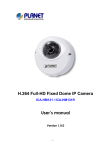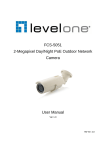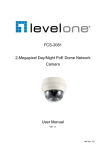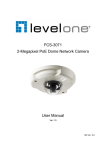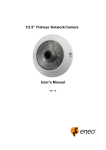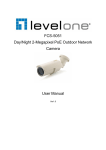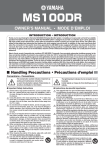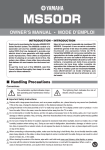Download Full HD IP Camera - PLANET Technology Corporation.
Transcript
H.264 Full-HD Fixed Dome IP Camera ► ICA-HM131/ICA-HM131R -1- Copyright Copyright (C) 2012 PLANET Technology Corp. All rights reserved. The products and programs described in this User’s Manual are licensed products of PLANET Technology, This User’s Manual contains proprietary information protected by copyright, and this User’s Manual and all accompanying hardware, software, and documentation are copyrighted. No part of this User’s Manual may be copied, photocopied, reproduced, translated, or reduced to any electronic medium or machine-readable form by any means by electronic or mechanical. Including photocopying, recording, or information storage and retrieval systems, for any purpose other than the purchaser's personal use, and without the prior express written permission of PLANET Technology. Disclaimer PLANET Technology does not warrant that the hardware will work properly in all environments and applications, and makes no warranty and representation, either implied or expressed, with respect to the quality, performance, merchantability, or fitness for a particular purpose. PLANET has made every effort to ensure that this User’s Manual is accurate; PLANET disclaims liability for any inaccuracies or omissions that may have occurred. Information in this User’s Manual is subject to change without notice and does not represent a commitment on the part of PLANET. PLANET assumes no responsibility for any inaccuracies that may be contained in this User’s Manual. PLANET makes no commitment to update or keep current the information in this User’s Manual, and reserves the right to make improvements to this User’s Manual and/or to the products described in this User’s Manual, at any time without notice. If you find information in this manual that is incorrect, misleading, or incomplete, we would appreciate your comments and suggestions. CE mark Warning The is a class B device, In a domestic environment, this product may cause radio interference, in which case the user may be required to take adequate measures. WEEE Warning To avoid the potential effects on the environment and human health as a result of the presence of hazardous substances in electrical and electronic equipment, end users of electrical and electronic equipment should understand the meaning of the crossed-out wheeled bin symbol. Do not dispose of WEEE as unsorted municipal waste and have to collect such WEEE separately. Trademarks The PLANET logo is a trademark of PLANET Technology. This documentation may refer to numerous hardware and software products by their trade names. In most, if not all cases, their respective companies claim these designations as trademarks or registered trademarks. -2- Revision User’s Manual for PLANET H.264 Full-HD Fixed Dome IP Camera Model: ICA-HM131 / ICA-HM131R (V2) Rev: 1.0.0 (2012, May) Part No. EM-ICAHM131 Series -3- TABLE OF CONTENTS Chapter 1 Introduction..............................................................................................6 Overview ........................................................................................................................................ 6 Package Content........................................................................................................................... 7 Physical Details ............................................................................................................................ 7 Top View................................................................................................................................ 7 Side View .............................................................................................................................. 8 Chapter 2 Preparations for IP Cameam Setup ........................................................9 Physical Installation Requirement .............................................................................................. 9 2.1 System Requirements ............................................................................................................ 9 2.2 Ethernet Connection .............................................................................................................. 9 2.3 PoE Connection ...................................................................................................................... 9 Chapter 3 Accessing Camera................................................................................. 11 3.1 Device Search Software Setup .............................................................................................11 3.2 Device Search ....................................................................................................................... 12 3.3 Example of Changing IP Camera’s Network Property ...................................................... 13 3.4 Installing DC Viewer Software Online................................................................................. 15 3.5 Administrator / User Privileges ........................................................................................... 16 3.6 Lens Adjustment................................................................................................................... 16 Chapter 4 Configuration & Operation....................................................................18 4.1 Browser-based Viewer Introduction ................................................................................... 18 4.2 Home Page.......................................................................................................................... 19 4.3 System Related Settings ................................................................................................... 21 4.3.1 Host Name and System Time Setting ............................................................. 21 4.3.2 Security.............................................................................................................. 22 4.3.3 Network.............................................................................................................. 30 4.3.4 DDNS.................................................................................................................. 37 4.3.5 Mail..................................................................................................................... 38 4.3.6 FTP ..................................................................................................................... 38 4.3.7 HTTP .................................................................................................................. 39 4.3.8 Motion Detection............................................................................................... 40 4.3.9 Network failure detection................................................................................. 43 4.3.10 Tampering Alarm............................................................................................... 45 4.3.11 Storage Management (Local Recording)........................................................ 49 4.3.12 Recording (Local Recording) .......................................................................... 51 4.3.13 File Locatioin..................................................................................................... 52 4.3.14 View information............................................................................................... 52 4.3.15 Factory Default.................................................................................................. 54 4.3.16 Software Version............................................................................................... 56 -4- 4.3.17 Software Upgrade ............................................................................................. 57 4.3.18 Maintenance ...................................................................................................... 60 4.4 Video and Audio Streaming Settings.................................................................................. 61 4.4.1 Video format (Video Resolution/ Video Deinterlace)..................................... 61 4.4.2 Video Compression .......................................................................................... 63 4.4.3 Video ROI........................................................................................................... 64 4.4.4 Video OCX Protocol.......................................................................................... 65 4.4.5 Video Frame Rate ............................................................................................. 66 4.4.6 Video Mask ........................................................................................................ 67 4.4.7 Audio Mode and Bit Rate Settings.................................................................. 67 4.5 Camera Settings ................................................................................................................... 69 4.5.1 Exposure Setting .............................................................................................. 69 4.5.2 White Balance Setting...................................................................................... 70 4.5.3 Brightness Setting............................................................................................ 71 4.5.4 Backlight............................................................................................................ 72 4.5.5 Digital Zoom ...................................................................................................... 72 4.5.6 WDR Function ................................................................................................... 72 4.5.7 Noise Reduction ............................................................................................... 73 4.5.8 TV System Setup .............................................................................................. 73 4.6 Logout ................................................................................................................................. 74 Appendix A: IP Camera Specifications..................................................................................... 75 Appendix B: Internet Security Settings.................................................................................... 76 Appendix C: DC Viewer Download Procedure......................................................................... 79 Appendix D: Frequently Asked Questions............................................................................... 81 -5- Chapter 1 Introduction 1 Overview PLANET has announced a H.264 Full-HD Fixed Dome IP camera, ICA-HM131/131R, for meeting the feedback from worldwide market. The ICA-HM131 series support Full HD recording for high quality image. Integrated the next generation video compression technology – H.264, the ICA-HM131 series can compress the video size to smaller one for users to transfer the Mega-Pixel image on Internet easily. The ICA-HM131 series IP Cameras are innovatively designed for quick and easy installation in drop ceilings without concerning the outlet / socket locations. Power over Ethernet (IEEE 802.3af) supplies power to the cameras via the network, eliminating the need for power cables and reducing installation costs. Multi-profile stands for video stream simultaneously. The ICA-HM131 series can deliver clear image with dual H.264/M-JPEG stream video up to 1080p (1920 x 1080 pixels). The IP Cameras use progressive scan, providing full resolution images of moving objects without distortion, in 30 frames per second, perfect for critical areas such as entrances or checkouts that need to be monitored in greater detail. The ICA-HM131 series can be managed by PLANET Cam Viewer Three, the professional management software for multi-camera video surveillance application, to provide monitoring, recording and event management functions. The Cam Viewer Three enables you to setup a comprehensive and effective surveillance system quickly and easily. With the ICA-HM131 series managed by the Cam Viewer Three, it provides an enhanced professional security environment to protect your property and life. Product Features Camera • 1/2.7” progressive CMOS • Dual video stream : H.264 and M-JPEG video compression simultaneously • Supports 1080p Full-HD resolution (1920 x 1080 pixels) • Compliant with IEEE 802.3af PoE interface • Supports ONVIF Standard to Simplify Integration and Enhance Interoperability Video & Audio • 3GPP for 3G mobile remote applications • Built-in Microphone for one-way audio • Supports Micro SD card storage Management -6- • Easy configuration and management via Windows-Based utility or web interface • Cam Viewer Three - Central management software supported • DDNS, PPPoE and FTP uploading supports more alternatives in surveillance network Feature • Motion Detection feature can monitor any suspicious movement in specific area • Wide Dynamic Range (WDR) / 3D Noise Reduction (3DNR) function support • Planet DDNS function support Package Content The contents of your product should contain the following items: IP Camera Quick installation guide User’s manual CD Accessories Kit Physical Details Top View -7- 4. Tilt Fixed 1. Lens Screw 2. Reset Button 5. Microphone 3. Focus Fixed Screw Top View of ICA-HM131/131R Item Description 1 Lens Rotate the lens right/left to adjust focus 2 Reset Button Restore to default setting, press the button with a proper tool 3 Focus Fixed Screw Loosen the screw to adjust the lens 4 Tilt Fixed Screw Loosen the screw to adjust tilt angle 5 Microphone The IP Camera has built-in an internal microphone. This microphone is hidden in the internal case. Side View 2. RJ-45 LAN Socket 1. Micro-SD Card slot Side View of ICA-HM131/131R Item 1 2 Description Micro-SD Card slot User can insert a micro SD card into this slot for event recording. RJ-45 LAN Socket The LAN socket is a RJ-45 connector for connections to 10/100Base-TX Fast Ethernet cabling. The LAN socket is compliant with IEEE802.3af standard PoE interface, and IP Camera is necessary supplied power through PoE Switch/Hub device. -8- Chapter 2 Preparations for IP Cameam Setup 2 Physical Installation Requirement The notices and introduction on system installation will be described particularly in this chapter. Please follow the description to operate the unit. In order to prevent the unit from data loss and system damage that caused by a sudden power fluctuation, use of an Uninterruptible Power Supply (UPS) is highly recommended. 2.1 System Requirements To perform the IP Camera via web browser, please ensure your PC is in good network connection, and meet system requirements as described below for appropriate setup and well view quality. Items System Requirement Personal Computer 1. Intel○R CoreTM2 Duo, 2.0 GHz or Intel○R Core™ i3 Processor 2. 2 GB RAM or more Operating System Windows 7 or Windows XP Web Browser Microsoft Internet Explorer 6.0 or later Network Card 10Base-T (10 Mbps) or 100Base-TX (100 Mbps) operation Viewer ActiveX control plug-in for Microsoft IE 2.2 Ethernet Connection Please follow the instructions below to connect this IP Camera’s Ethernet cable. 2.3 PoE Connection Connect the one end of the Ethernet cable to the network port on the camera, and the other end to Power Sourcing Equipment (PSE) like 802.3af POE Hub/ Injector or 802.3af POE Switche. Check the status of the link indicator and activity indicator LEDs; if the LEDs are unlit, please check the connections. Green Link Light indicates good network connection. Orange Activity Light flashes for network activity indication. -9- 1. The RJ-45 interface only accept IEEE802.3af PSE (Power Source Equipmetns) Any non-standard or passive POE is not allowed to Note power the system and will damage the IP Camera permanently. 2. You can also consult your local dealer for 802.3af POE PSE devices such as single port injector for single point installation. Or, for mass installation, a Injector Hub for the network that already existed with Ethernet Switches or POE Switch all can be deployed. - 10 - Chapter 3 Accessing Camera 3 For initial access to the IP Camera, users can search the camera through the installer program: DeviceSearch.exe, which can be found in “DeviceSearch” folder in the supplied CD. 3.1 Device Search Software Setup Step 1: Double click on the program Planet Device Search.exe (see the icon below); its window will appear as shown below. Then click the “Device Search” button. Step 2: The security alert window will pop up. Click “Run” to continue. - 11 - 3.2 Device Search Step 3: Click “Device Search” again, and all the finding IP devices will be listed in the page, as shown in the figure below. The IP Camera’s default IP address is: 192.168.0.20. Step 4: Double click or right click and select “Browse” to access the camera directly via web browser. Step 5: Then the prompt window of request for entering default username and password (as shown below) will appear for logging in to the IP Camera. - 12 - The default login ID and password for the Administrator are: Login ID Password admin admin NOTE: ID and password are case sensitive. NOTE: It is strongly advised that administrator’s password be altered for the security concerns. Refer to section 4.3.2 Security for further details. Additionally, users can change the IP Camera’s network property, either DHCP or Static IP, directly in the device finding list. Refer to the following section for changing the IP Camera’s network property. 3.3 Example of Changing IP Camera’s Network Property Users can directly change an IP Camera’s network property, ex. from static IP to DHCP, in the finding device list. The way to change the IP Camera’s network property is specified below: Step 1: In the finding device list, click on the IP Camera that you would like to change its network property. On the selected item, right click and select “Network Setup.” Meanwhile, record the IP Camera’s MAC address, for future identification. Step 2: The “Network Setup” page will come out. Select “DHCP,” and press “Apply” button down the page. - 13 - Step 3: Click “OK” on the Note of setting change. Wait for one minute to re-search the IP Camera. Step 4: Click the “Device Search” button to search all the devices. Then select the IP Camera with the correct MAC address. Double click on the IP Camera, and the login window will come out. Step 5: Enter User name and Password to access the IP Camera. - 14 - 3.4 Installing DC Viewer Software Online For the initial access to the IP Camera, a client program, DC Viewer, will be automatically installed to your PC when connecting to the IP Camera. If the Web browser doesn’t allow DC Viewer installation, please check the Internet security settings or ActiveX controls and plug-ins settings (see Appendix B: Internet Security Settings) to continue the process. The Information Bar (just below the URL bar) may come out and ask for permission to install the ActiveX Control for displaying video in browser (see the figure below). Right click on the Information Bar and select “Install ActiveX Control…” to allow the installation. Then the security warning window will pop up. Click “Install” to carry on software installation. Click “Finish” to close the DC Viewer window when download is finished. For the detailed software download procedure, please refer to Appendix C: DC Viewer Download Procedure. Once login to the IP Camera, users will see the Home page as shown below: - 15 - 3.5 Administrator / User Privileges “Administrator” represents the person who can configure the IP Camera and authorize users access to the camera; “User” refers to whoever has access to the camera with limited authority, i.e. entering Home and Camera setting pages. 3.6 Lens Adjustment The image displays on the Home page when successfully accessing to the IP Camera. Adjust the camera’s focus to produce a clear image. Please refer to the procedure below. Step 1: Unscrew the IP Camera’s cover. - 16 - Step 2: Loosen the focus fixed screw, and rotate the lens counter-/clockwise to adjust focus; loosen the tilt fixed screw, and adjust the camera’s tilt angle. Tilt Fixed Screw Focus Fixed Screw - 17 - Chapter 4 Configuration & Operation 4 The IP Camera is provided with a user-friendly browser-based configuration interface, and a free bundled CV3L (Cam Viewer Three Lite) for record and playback video. In this chapter, information about main page introduction, system related settings and camera settings will be described in detail. 4.1 Browser-based Viewer Introduction The figure below shows the Home page of the IP Camera’s Viewer Window. There are five tabs: Home, System, Streaming, Camera and Logout on the top of the viewer window. - 18 - Home Users can monitor live video of the targeted area. System setting The administrator can set host name, system time, root password, network related settings, etc. Further details will be interpreted in section 4.3 System Related Settings. Streaming setting The administrator can modify video resolution and rotate type and select audio compression mode in this page. Camera setting Users can adjust various camera parameters, including <Exposure>, <White Balance>, <Brightness>, <Sharpness>, <Contrast> and <Digital Zoom>. Logout Click on the tab to re-login the IP Camera with another username and password. 4.2 Home Page In the Home page, there are several function buttons right down the displayed image. Screen Size Adjustment Image display size can be adjusted to x1/2 and full screen. - 19 - Digital Zoom Control In the full screen mode, users can implement digital zoom by right clicking the mouse, rotating the mouse wheel (for zoom in/out) and dragging the mouse into any direction. Snapshot Press the button, and the JPEG snapshots will automatically be saved in the appointed place. The default place of saving snapshots is: C:\. Talk Talk function allows the local site talks to the remote site. Please refer to section 4.3.2 Security: Add user > Talk/Listen for further details. This function is only open to “User” who has been granted this privilege by the Administrator. Speaker Press the button to mute/activate the audio. Video Pause / Restart Press the stop button to disable video streaming, the live video will be displayed as black. Press the restart button to show the live video again. Recording Press the button to save video recordings from the Live View to the specified location. - 20 - 4.3 System Related Settings The figure below shows all categories under the “System” tab. Each category in the left column will be explained in the following sections. NOTE: The “System” configuration page is only accessible by the Administrator. 4.3.1 Host Name and System Time Setting Press the first category: <System> in the left column; the page is shown as below. Host Name The name is for camera identification. If Motion Detection function is enabled and is set to send alarm message by Mail/FTP, the host name entered here will display in the alarm message. Time Zone Select the time zone you are in from the drop-down menu. Enable Daylight Saving Time - 21 - To enable DST, please check the item and then specify time offset and DST duration. The format for time offset is [hh:mm:ss]; for instance, if the amount of time offset is one hour, please enter “01:00:00” into the field. Sync With Computer Time Select the item, and video date and time display will synchronize with the PC’s. Manual The Administrator can set video date, time and day manually. Entry format should be identical with that shown next to the enter fields. Sync with NTP server Network Time Protocol (NTP) is an alternate way to synchronize your camera’s clock with a NTP server. Please specify the server you wish to synchronize in the enter field. Then select an update interval from the drop-down menu. For further information about NTP, please see the web site: www.ntp.org. 4.3.2 Security Click the category: <Security>, and the page is shown as the figure below. 4.3.2.1 User - 22 - Root password Change the administrator’s password by inputting the new password in both text boxes. The input characters/numbers will be displayed as dots for security purposes. After clicking <Save>, the web browser will ask the Administrator for the new password for access. The maximum length of the password is 14 digits. NOTE: The following characters are valid: A-Z, a-z, 0-9, !#$%&’-.@^_~. Add user Type the new user's name and password and click <Add> to add the new user. Both user name and password can be up to 16 characters. The new user will be displayed in the user name list. There is a maximum of twenty user accounts. Each user can be assigned the privileges of “Camera control” and/or “Listen”. • I/O access This item supports fundamental functions that enable users to view video when accessing to the camera. • Camera control This item allows the appointed User to change camera parameters on the Camera Setting page. • Listen Listen functions allow the administrator hear the sounds in the local site (PC site). NOTE: The IP Camera does not have the Talk function. Manage User Delete user To delete a user, pull down the user list, and select the user name you wish to delete. Then click <Delete> to remove it. Edit user Pull down the user list and select a user name. Click <Edit> to edit the user’s password and privilege. NOTE: It is required to enter the User password as well as select the function open to the user. When finished, click <Save> to modify the account authority. - 23 - 4.3.2.2 HTTPS <HTTPS> allows secure connections between the IP Camera and web browser using <Secure Socket Layer (SSL)> or <Transport Layer Security (TLS)>, which ensure camera settings or Username/ Password info from snooping. It is required to install a self-signed certificate or a CA-signed certificate for implementing <HTTPS>. - 24 - To use HTTPS on the IP Camera, a HTTPS certificate must be installed. The HTTPS certificate can be obtained by either creating and sending a certificate request to a Certificate Authority (CA) or creating a self-signed HTTPS certificate, as described below. Create Self-signed Certificate Before a CA-issued certificate is obtained, users can create and install a self-signed certificate first. Click on <Create> button under “Create self-signed certificate” and provide the requested information to install a self-signed certificate for the IP Camera. Please refer to the last part of this section: Provide the Certificate Information for more details. The self-signed certificate does not provide the same high level of security as when using Note a CA-issued certificate. Install Signed Certificate Click on the <Create Certificate Request> button to create and submit a certificate request in order to obtain a signed certificate from CA. - 25 - Provide the request information in the create dialog. Please refer to the following Provide the Certificate Information for more details. When the request is complete, the subject of the Created Request will be shown in the field. Click on <Properties> below the Subject field, copy the PEM-formatted request and send it to your selected CA. When the signed certificate is returned, install it by uploading the signed certificate. Provide the Certificate Information To create a Self-signed HTTPS Certificate or a Certificate Request to CA, please enter the information as requested: Create Self Signed Certificate √ √ State or Province √ √ Locality √ √ Organization √ √ Organizational Unit √ √ Common Name √ √ Valid Day √ - Country • Create Certificate Request Country Enter a two-letter combination code to indicate the country the certificate will be used in. For instance, type in “US” to indicate United States. • State or province Enter the local administrative region. - 26 - • Locality Enter other geographical information. • Organization Enter the name of the organization to which the entity identified in “Common Name” belongs. • Organization Unit Enter the name of the organizational unit to which the entity identified in “Common Name” belongs. • Common Name Indicate the name of the person or other entity that the certificate identifies (often used to identify the website). • Valid days Enter the period in days (1~9999) to indicate the valid period of certificate. Click on <OK> to save the Certificate Information after complete. - 27 - 4.3.2.3 IP Filter The IP Filter setting can be found under this path: System> Security> IP Filter. Using the IP filter, access to the IP Camera can be restricted by denying/allowing specific IP addresses. z Enable IP Filter Check the box to enable the IP Filter function. Once enabled, the listed IP addresses (IPv4) will be allowed/ denied access to the IP Camera. Select <Allow> or <Deny> from the drop-down list and click on the <Apply> button to determine the IP Filter behavior. z Add/ Delete IP Address Input the IP address and click on the <Add> button to add a new filtered address. The Filtered IP Addresses list box shows the currently configured IP addresses. Up to 256 IP address entries may be specified. To remove an IP address from the list, please select the IP and then click the <Delete> button. - 28 - 4.3.2.4 IEEE 802.1X The IEEE 802.1X setting can be found under this path: System> Security> IEEE 802.1X. The IP Camera is allowed to access a network protected by 802.1X/EAPOL (Extensible Authentication Protocol over LAN). Users need to contact with the network administrator for gaining certificates, user IDs and passwords CA Certificate The CA certificate is created by the Certification Authority for the purpose of validating itself. Upload the certificate for checking the server’s identity. Client Certificate/ Private Key Upload the Client Certificate and Private Key for authenticating the IP Camera itself. Settings • Identity Enter the user identity associated with the certificate. Up to 16 characters can be used. - 29 - • Private Key Password Enter the password (maximum 16 characters) for your user identity. Enable IEEE 802.1X Check the box to enable IEEE 802.1X. Click on <Save> to save the IEEE 802.1X/ EAP- TLS setting. 4.3.3 Network Click <Network> in the left column, and the page will display as shown below. 4.3.3.1 Basic Users can choose to use fixed IP address or dynamic (DHCP) IP address. The following is descriptions for the two ways of setting IP address. - 30 - Get IP address automatically (DHCP) The camera’s default setting is “Use fixed IP address”. Please refer to the previous section Chapter 3. Accessing Camera for logging in with the default IP address. If select “Get IP address automatically”, after the IP Camera restarts, users can search it through the installer program: DeviceSearch.exe, which can be found in “DeviceSearch” folder in the supplied CD. NOTE: Please make the record of the IP Camera’s MAC address, which can be found in the label of the camera, for identification in the future. Use fixed IP address To setup static IP address, select “Use fixed IP address” and move the cursor to the IP address blank (as indicated below) and insert the new IP address, ex. 192.168.0.250; then go to the Default gateway (explained latter) blank and change the setting, ex. 192.168.0.250. Press “Save” to confirm the new setting. When using static IP address to login to the IP Camera, users can access it either through “DeviceSearch” software (see Chapter 3. Accessing Camera) or input the IP address in the URL bar - 31 - and press “Enter”. General • IP address This is necessary for network identification. • Subnet mask It is used to determine if the destination is in the same subnet. The default value is “255.255.255.0”. • Default gateway This is the gateway used to forward frames to destinations in different subnet. Invalid gateway setting will fail the transmission to destinations in different subnet. • Primary DNS Primary DNS is the primary domain name server that translates hostnames into IP addresses. • Secondary DNS Secondary DNS is a secondary domain name server that backups the primary DNS. • Web Server port The default web server port is 80. Once the port is changed, the user must be notified the change for the connection to be successful. For instance, when the Administrator changes the HTTP port of the IP Camera whose IP address is 192.168.0.100 from 80 to 8080, the user must type in the web browser “http://192.168.0.100:8080” instead of “http://192.168.0.100”. Advanced • RTSP port RTSP port could be set from 1 to 65535. (Normal Setting Port: 554, 1024 ~65535) • MJPEG over HTTP port The default setting of HTTP Port is 8008; setting range: 1024 ~65535. • HTTPS port The default setting of HTTPS Port is 443; the setting range is from 1024 to 65535. - 32 - NOTE: Be aware to choose the different port from the one set for the web server port. IPv6 Address Configuration With IPv6 support, users can use the corresponding IPv6 address for browsing. Enable IPv6 by checking the box and click on <Save> to complete the setting. 4.3.3.2 QoS The QoS (Quality of Service) setting can be found under this path: System> Network> QoS. QoS allows providing differentiated service levels for different types of traffic packets, which guarantees delivery of priority services especially when network congestion occurs. Adapting the Differentiated Services (DiffServ) model, traffic flows are classified and marked with DSCP (DiffServ Codepoint) values, and thus receive the corresponding forwarding treatment from DiffServ capable routers. DSCP Settings The DSCP value range is from 0 to 63. The default DSCP value is 0, which means DSCP is disabled. The IP Camera uses the following QoS Classes: Video, Audio and Management. - 33 - • Video DSCP The class consists of applications such as MJPEG over HTTP, RTP/RTSP and RTSP/HTTP. • Audio DSCP This setting is only available for the IP Cameras that support audio. • Management DSCP The class consists of HTTP traffic: Web browsing. NOTE: To enable this function, please make sure the switches/ routers in the network support QoS. 4.3.3.3 SNMP The SNMP (Simple Network Management Protocol) setting can be found under this path: System> Network> SNMP. - 34 - With Simple Network Management Protocol (SNMP) support, the IP Camera can be monitored and managed remotely by the network management system. SNMP v1/ v2 • Enable SNMP v1/ v2 Select the version of SNMP to use by checking the box. • Read Community Specify the community name that has read-only access to all supported SNMP objects. The default value is “public”. • Write Community Specify the community name that has read/write access to all supported SNMP objects (except read-only objects). The default value is “write”. Traps for SNMP v1/ v2 Traps are used by the IP Camera to send massages to a management system for important events or status changes. • Enable Traps Check the box to activate trap reporting. • Trap address Enter the IP address of the management server. • Trap community Enter the community to use when sending a trap message to the management system. Trap Option • Warm Start A Warm Start SNMP trap signifies that the SNMP device, i.e. IP Camera, performs software reload. Click on <Save> button when complete. 4.3.3.4 UPnP The UPnP setting can be found under this path: System> Network> UPnP. - 35 - UPnP Setting z Enable UPnP When the UPnP is enabled, whenever the IP Camera is presented to the LAN, the icon of the connected IP Cameras will appear in My Network Places to allow for direct access. NOTE: To enable this function, please make sure the UPnP component is installed on your computer. Please refer to Install UPnP components for UPnP component installation procedure. • Enable UPnP port forwarding When the UPnP port forwarding is enabled, the IP Camera is allowed to open the web server port on the router automatically. Note • To enable this function, please make sure that your router supports UPnP and it is activated. Friendly name Set the name for the IP Camera for identity. - 36 - 4.3.4 DDNS Dynamic Domain Name System (DDNS) allows a host name to be constantly synchronized with a dynamic IP address. In other words, it allows those using a dynamic IP address to be associated to a static domain name so others can connect to it by name. Enable DDNS Check the item to enable DDNS. Provider Select one DDNS host from the provider list. Host name Enter the registered domain name in the field. Example : planetddnstest01 Username/ Enter the username required by the DDNS provider for authentication. Example : planetddnstest01 Password - 37 - Enter the password required by the DDNS provider for authentication. Example : planetddnstest01 If you want to use Planet DDNS please aply form the Planet DDNS page Note http://www.planetddns.com/index.php 4.3.5 Mail The Administrator can send an e-mail via Simple Mail Transfer Protocol (SMTP) when motion is detected. SMTP is a protocol for sending e-mail messages between servers. SMTP is a relatively simple, text-based protocol, where one or more recipients of a message are specified and the message text is transferred. The configuration page is shown as follows: Two sets of SMTP can be configured. Each set includes SMTP Server, Account Name, Password and E-mail Address settings. For SMTP server, contact your network service provider for more specific information. 4.3.6 FTP The Administrator can set as sending alarm message to a specific File Transfer Protocol (FTP) site when motion is detected. Users can assign alarm message to up to two FTP sites. The FTP setting page is shown below. Enter the FTP details, which include server, server port, user name, password and remote folder, in the fields. Press “Save” when finished. - 38 - 4.3.7 HTTP The HTTP setting can be found under this path: System> HTTP. - 39 - A HTTP Notification server can listen for notification messages from IP Cameras by triggered events. Enter the HTTP details, which include server name (for instance, http://192.168.0.1/admin.php), user name, and password in the fields. <Alarm> triggered and <Motion Detection> notifications can be sent to the specified HTTP server. Click on <Save> when finished. 4.3.8 Motion Detection Motion Detection function allows detecting suspicious motion and triggering alarms when motion volume in the detected area reaches/exceeds the determined sensitivity threshold value. In the Motion Detection setting page, there is a frame (Motion Detection Window) displayed on the Live View Pane. The Motion Detection Window is for defining the motion detection area. To change the size of the Motion Detection Window, move the mouse cursor to the edge of the frame and draw it outward/inward. Moving the mouse to the center of the frame can shift the frame to the intended location. Up 10 Motion Detection Windows can be set. Press the “add” button under the Live View Pane to add a Motion Detection Window. To cancel a Motion Detection Window, move the mouse cursor to the selected Window, and click on the “delete” button. If Motion Detection function is activated, the pop-off window (Motion) with indication of motion will be shown. - 40 - When motion is detected, the signals will be displayed on the Motion window as shown below. Detailed settings of Motion Detection are described as follows: Motion Detection You will be able to turn on/off Motion Detection in System section. Default setting is Off. Motion Detection Setting Users could adjust various parameters of Motion Detection in this section. • Sampling pixel interval [1-100]: The default value is 10, which means system will take one sampling pixel for every 10 pixel. • Detection level [1-100]: The default level is 10. The item is to set detection level for each sampling pixel; the smaller the value, the more sensitive it is. • Sensitivity level [1-100]: The default level is 80, which means if 20% or more sampling pixels are detected differently, system will detect motion. The bigger the value, the more sensitive it is. Meanwhile, when the value is bigger, the red horizontal line in the motion indication window will be lower accordingly. • Time interval (sec) [0-7200]: The default interval is 10. The value is the interval between each detected motion. - 41 - Users could adjust the parameter and level of Motion Detection Settings. • Sampling pixel interval [1-100]: Default value: 10 • Detection level [1-100]: Default value: 10 • Sensitivity level [1-100]: Default value: 80 • Time interval (sec) [0-7200]: Default value: 10 Total four actions could be selected once the motion is detected. Triggered Action (Multi-option) The Administrator can specify alarm actions that will take when motion is detected. All options are listed as follows: • Enable Alarm Output Check the item and select the predefined type of alarm output to enable alarm relay output when motion is detected. NOTE: This option is excluded in the IP Camera. • Send Alarm Message by FTP/E-Mail The Administrator can select whether to send an alarm message by FTP and/or E-Mail when motion is detected. • Upload Image by FTP Select this item, and the Administrator can assign a FTP site and configure various parameters as shown in the figure below. When motion is detected, event images will be uploaded to the appointed FTP site. • Upload Image by E-Mail Select this item, and the Administrator can assign an e-mail address and configure various parameters as shown in the figure below. When motion is detected, event images will be sent to the appointed e-mail address. - 42 - NOTE: Make sure SMTP or FTP configuration has been completed. See section 4.3.5 Mail and 4.3.6 FTP for further details. Send HTTP notification Check this item, select the destination HTTP address, and specify the parameters for event notifications by <Motion Detection> triggered. When an alarm is triggered, the notification can be sent to the specified HTTP server. For instance, if the custom parameter is set as” action=1&group=2”, and the HTTP server name is” http://192.168.0.1/admin.php”, the notification will be sent to HTTP server as” http://192.168.0.1/admin.php? action=1&group=2” when alarm is triggered. File Name The uploaded image’s filename format can be set in this section. Please select the one that meets your requirements. Save Click the Save button to save all the Motion Detection settings mentioned above. 4.3.9 Network failure detection Network Failure Detection allows the IP Camera to ping another IP device (e.g.NVR, VSS, Video Server, etc.) within the network periodically and generates some actions in case of network failure occurs, for instance, a Video Server is somehow disconnected The Tampering setting can be found under this path: System> Network failure detection - 43 - Being capable of implementing local recording (through Micro SD card) when network failure happens, the IP Camera could be a backup recording device for the surveillance system. Detection Switch You will be able to turn on/off Network Failure Detection in System section. Default setting is Off. Detection Type Input the IP device address and the period of ping time to ping. The ping time setting range is from 1 to 99 minutes. Triggered Action (Multi-option) The Administrator can specify alarm actions that will take when network failure is detected. All options are listed as follows: • Record stream to SD Card Select this item and the Tampering Alarm recording will be stored in Micro SD/ SDHC card when tampering is detected. Pre-trigger buffer recording function allows users to check what happened to cause the trigger. The pre-trigger buffer time range is from 1 to 3 seconds. Select <Upload for __ sec> to set the recording - 44 - duration after alarm is triggered. The setting range is from 1 to 99999 seconds. Select <Upload during the trigger active> to record the triggered video until the trigger is off. Please make sure the local recording (with Micro SD/ SDHC card) is activated so that this Note • function can be implemented. Refer to Recording for further details. Upload Image by FTP Select this item and the Administrator can assign a FTP site and configure various parameters. When tampering is detected, event images will be uploaded to the appointed FTP site. • Upload Image by E-Mail Select this item and the Administrator can assign an e-mail address and configure various parameters. When tampering is detected, event images will be sent to the appointed e-mail address. Make sure SMTP or FTP configuration has been completed. Refer to Mail and FTP for Note further details. 4.3.10 Tampering Alarm The Tampering setting can be found under this path: System> Tampering. Tampering Alarm function helps the IP Camera against tampering such as deliberate redirection, blocking, paint spray, and lens cover, etc through video analysis and reaction to such events by sending out notifications or uploading snapshots to the specified destination(s). Detection of camera tampering is achieved by measuring the differences between the older frames of video (which are stored in buffers) and more recent frames. Tampering Alarm Users are able to turn on/off Tampering Alarm function in Tampering Alarm setting page. The default setting is Off. - 45 - Tampering Duration Minimum Tampering Duration is the time for video analysis to determine whether camera tampering has occurred. Minimum Duration could also be interpreted as defining the Tampering threshold; longer duration represents higher threshold. Settable Tampering Duration time range is from 10 to 3600 seconds. The Default value is 20 seconds. Triggered Action (Multi-option) The Administrator can specify alarm actions that will take when tampering is detected. All options are listed as follows: z Enable Alarm Output Check the item and select the predefined type of alarm output to enable alarm output when tampering is detected. z Record stream to SD Card Select this item and the Tampering Alarm recording will be stored in Micro SD/ SDHC card when tampering is detected. Pre-trigger buffer recording function allows users to check what happened to cause the trigger. The pre-trigger buffer time range is from 1 to 3 seconds. Select <Upload for __ sec> to set the recording duration after tampering occurs. The setting range is from 1 to 99999 seconds. Select <Upload during the trigger active> to record the triggered video until the trigger is off. NOTE: Please make sure the local recording (with Micro SD/ SDHC card) is activated so that this function can be implemented. Refer to Recording for further details. z Send Message by FTP/E-Mail The Administrator can select whether to send an alarm message by FTP and/or E-Mail when tampering is detected. z z Upload Image by FTP Select this item and the Administrator can assign a FTP site and configure various parameters. When tampering is detected, event images will be uploaded to the appointed FTP site. <Pre-trigger buffer> function allows users to check what happened to cause the trigger. The <Pre-trigger buffer> frame rate could be pre-determined. - 46 - On the other hand, <Post-trigger buffer> is for users to upload certain amount of images after tampering is triggered. Check the box <Continue image upload> to upload the triggered images during certain time or keep uploading until the trigger is off. Select <Upload for __sec> and enter the duration in the blank. The images of the duration will be uploaded to FTP when tampering is triggered. The setting range is from 1 to 9999 seconds. Select <Upload during the trigger active> to make the images keep being upload to FTP during the trigger active until the tampering stops. Set the Image frequency as the upload frame rate. The setting range is from 1 frame to 15 frames. NOTE: Make sure FTP configuration has been completed. Refer to FTP for further details. z Upload Image by E-Mail Select this item and the Administrator can assign an e-mail address and configure various parameters. When tampering is detected, event images will be sent to the appointed e-mail address. <Pre-trigger buffer> function allows users to check what happened to cause the trigger. The <Pre-trigger buffer> frame rate could be pre-determined. On the other hand, <Post-trigger buffer> is for users to upload certain amount of images after tampering occurs. Check the box <Continue image upload> to upload the triggered images during certain time or keep uploading until the trigger is off. Select <Upload for __sec> and enter the duration in the blank. The images of the duration will be uploading by E-mail when tampering is triggered. The setting range is from 1 to 9999 seconds. Select <Upload during the trigger active> to make the images keep being upload to E-mail during the trigger active until tampering stops. Set the Image frequency as the upload frame rate. The setting range is from 1 frame to 20 frames. NOTE: Make sure SMTP configuration has been completed. Refer to Mail for further details. z Send HTTP notification Check this item, select the destination HTTP address, and specify the parameters for HTTP notifications. When the Tampering Alarm is triggered, the HTTP notifications can be sent to the specified HTTP server. For instance, if the custom parameter is set as” action=1&group=2”, and the HTTP server name is” http://192.168.0.1/admin.php”, the notification will be sent http://192.168.0.1/admin.php? action=1&group=2” when alarm is triggered. - 47 - to HTTP server as” File Name Enter a file name in the blank, ex. image.jpg. The uploaded image’s file name format can be set in this section. Please select the one that meets your requirements. Add date/time suffix File name: imageYYMMDD_HHNNSS_XX.jpg Y: Year, M: Month, D: Day H: Hour, N: Minute, S: Second X: Sequence Number z Add sequence number suffix (no maximum value) File name: imageXXXXXXX.jpg X: Sequence Number z Add sequence number suffix up to # and then start over File Name: imageXX.jpg X: Sequence Number The file name suffix will end at the number being set. For example, if the setting is up to “10,” the file name will start from 00, end at 10, and then start all over again. z Overwrite The original image in the FTP site will be overwritten by the new uploaded file with a static filename. Save Click on the <Save> button to save all the Tampering Alarm settings mentioned above. - 48 - 4.3.11 Storage Management (Local Recording) The Storage Management setting can be found under this path: System> Storage Management. - 49 - Users can implement local recording to the Micro SD/SDHC card up to 32GB. This page shows the capacity information of the Micro SD card and a recording list with all the recording files saved on the memory card. Users can also format the SD card and implement automatic recording cleanup through the setting page. To implement Micro SD card recording, please go to the <Recording> page (refer to the section Recording) for activation. Please format the Micro SD/SDHC card when using for the first time. Formatting will also be required when a memory card already being used on one camera and later transferred Note to another camera with different software platform. Device information When users insert the Micro SD/SDHC card, the card information such as the memory capacity and status will be shown at Device Information section. When the memory card is successfully installed, the memory card status shall be shown at <Device information> section in the Storage Management page. Device setting Click on the <Format> button to format the memory card. Disk cleanup setting Users can enable automatic recordings cleanup by specifying the time and storage limits. Recording List Each video file on the Micro SD/SDHC card will be listed in the Recording list. The maximum file size is 60 MB/per file. When the recording mode is set as <Always> (consecutive recording) and the Micro SD/ SDHC card recording is also allowed to be enabled by events triggered, once events occur, the system will immediately implement events recording to the memory card. Then the IP Camera will return to the regular recording mode after events recording. • Remove To remove a file, select the file first, and then click on the <Remove> button. • Sort Click on the <Sort> button, and the files in the Recording list will be listed in name and date order. - 50 - The capital letter A/M/R appears in the very beginning of name denotes the sort of the Note • recording: A stands for Alarm; M stands for Motion; R stands for regular recording. Download To open/download a video clip, select the file first, and then click on the <download> button below the Recording list field. The selected file window will pop up. Click on the AVI file to directly play the video in the player or download it to a specified location. 4.3.12 Recording (Local Recording) The Recording setting can be found under this path: System> Recording. In the Recording setting page, users can specify the recording schedule that fits the present surveillance requirement. Activating Micro SD/SDHC Card Recording Two types of schedule mode are offered: Always and Time Frame setting. Users can setup the time frame to fit the recording schedule or choose <Always> to activate Micro SD/SDHC Card Recording all the time. Please click on the <Save> button for confirming the schedule mode. - 51 - Terminating Micro SD/SDHC Card Recording Select <Disable> to terminate the recording function. 4.3.13 File Locatioin Users can specify a storage location for the snapshots and live video recording. The default setting is: C:\. Once confirm the setting, press “Save,” and all the snapshots and recording will be saved in the designate location. Please make sure the selected file path contains valid characters such as letters and Note 4.3.14 numbers. View information Click on the link to view the system log file. The content of the file provides useful information about configuration and connections after system boot-up. 4.3.14.1 Log File The View Log File function can be found under this path: System> View Log File. - 52 - 4.3.14.2 View User Information The View User Information function can be found under this path: System> View User Information. The Administrator can view each added user’s login information and privileges (refer to the section Security). - 53 - Get User Information All the users in the network will be listed in the <User information> zone, as “User: 4321.” It indicates that one user’s login username is “User”, and password is “4321”. Get User Privacy Click on <get user privacy> at the bottom of the page, and the Administrator can view each user’s privileges as “User: 1:1:0:1.” 1:1:0:1= I/O access : Camera control : Talk : Listen (refer to the section Security) Therefore, it denotes the user is granted privileges of I/O access, Camera control and Listen. 4.3.14.3 View Parameters The View Parameters function can be found under this path: System> View Parameter. Click on this item to view the entire system’s parameter setting. 4.3.15 Factory Default The factory default setting page is shown as below. Follow the instructions to reset the IP Camera to factory default setting if needed. - 54 - Set Default Click on the “Set Default” button to recall the factory default settings. Then the system will restart in 30 seconds. The IP address will be restored to default. Note Reboot Click on the “Reboot” button, and the system will restart without changing current settings. - 55 - 4.3.16 Software Version The current software version is displayed in the software version page, which is shown as the figure below. - 56 - 4.3.17 Software Upgrade Software upgrade can be carried out in the “Software Upgrade” page as shown below. NOTE: Make sure the upgrade software file is available before carrying out software upgrade. The procedure of software upgrade is like the following: Step 1: Click “Browse” and select the binary file to be uploaded, ex.Userland.jffs2. - 57 - NOTE: Do not change the upgrade file name, or the system will fail to find the file. Step 2: Pull down the upgrade binary file list and select the file you want to upgrade; in this case, select “userland.jffs2.” Step 3: Press “Upgrade”. The system will first check whether the upgrade file exists or not, and then begin to upload the upgrade file. Subsequently, the upgrade status bar will display on the page. When it runs to 100%, the upgrade process is finished. - 58 - After the upgrade process is finished, the viewer will return to Home page. Step 4: Close the video browser. Step 5: Click “Control Panel”, and then double click “Add or Remove Programs.” In the “Currently install programs” list, select “DCViewer” and click the button “Remove” to uninstall the existing DC Viewer. Step 6: Open a new web browser, re-login the IP Camera, and then allow the automatic download of DC Viewer. - 59 - 4.3.18 Maintenance The Maintenance setting can be found under this path: System> Maintenance. Users can export configuration files to a specified location and retrieve data by uploading an existing configuration file to the IP Camera. Export Users can save the system settings by exporting the configuration file (.bin) to a specified location for future use. Click on the <Export> button, and the popup File Download window will come out. Click on <Save> and specify a desired location for saving the configuration file. Upload To copy an existing configuration file to the IP Camera, please click on <Browse> to select the configuration file first, and then click on the <Upload> button for uploading. - 60 - 4.4 Video and Audio Streaming Settings Press the tab ”Streaming” in the top of the page, and the configurable video and audio items will display in the left column. In Streaming, the Administrator can configure specific video resolution, video compression mode, video protocol, audio transmission mode, etc. Further details of these settings will be specified in the following sections. 4.4.1 Video format (Video Resolution/ Video Deinterlace) The Video Format setting can be found under this path: Streaming> Video Format.. Video Format Under Video Resolution section, the available video resolution formats are including MJPEG and H.264. Please refer to the Video Format for more combination details. Click on <Save> to confirm the setting. Text Overlay Settings Users can select the items to display data including date/time/text on the live video pane. The maximum length of the string is 20 alphanumeric characters. - 61 - Click on <Save> to confirm the Text Overlay setting. Video Rotate Type Users can change video display type if necessary. Selectable video rotate types include Normal, Flip, Mirror, 90 degree clockwise, 180 degree rotate and 90 degree counterclockwise. Differences among these types are illustrated as below. Suppose the displayed image of the IP Camera is shown as the figure below. To rotate the image, users can select <Flip>, for instance. Then the displayed image will be reversed as shown below. The following is descriptions for different video rotate type. • Flip If select <Flip>, the image will be rotated vertically. • Mirror If select <Mirror>, the image will be rotated horizontally. - 62 - • 90 Degree Counter-/clockwise Selecting <90 Degree Counter-/clockwise> will make the image 90° counter-/clockwise inversed. • 180 Degree Rotate Selecting <180 Degree> will make the image 180°inversed. Click on <Save> to confirm the setting. GOV Settings Users can set the GOV length to determine the frame structure (I-frames and P-frames) in a video stream for saving bandwidth. Longer GOV means decreasing the frequency of I-frames. Click <Save> to confirm the GOV setting. H.264 Profile Users can set each H.264 Profile to <Baseline Profile>, <Main Profile> or <High Profile> according to its compression needs. With the same bit rate, the higher the compression ratio, the better the image quality is. The default setting is <Main Profile>. NOTE: Please make sure the higher compression ratio is supported by system before setup. 4.4.2 Video Compression The Video Compression setting can be found under this path: Streaming> Video Compression. - 63 - Users can select a proper MJPEG/H.264 compression mode on the video compression page, depending on the application. MJPEG Q (Quality) factor Higher value implies higher bit rates and higher visual quality. The default setting of MJPEG Q factor is 35; the setting range is from 1 to 70. H.264-1/ H.264-2 bit rate The default setting of H.264-1/ H.264-2 is 4096/1024 kbps; the setting range is from 64 to 8192 kbps. Display Compression Information Users can also decide whether to display compression information on the Home page. CBR Mode Setting The CBR (Constant Bit Rate) mode could be the preferred bit rage mode if the bandwidth available is limited. It is important to take account of image quality while choosing to use CBR mode. Click “Save” to confirm the setting. 4.4.3 Video ROI The Video ROI setting can be found under this path: Streaming> Video ROI. ROI stands for Region of Interest. This function allows users to select specific monitoring region for 2nd, 3rd and 4th streams, instead of showing the full image. NOTE: This function is only available when triple streams or above is selected under Video Resolution in Video Format Setting. Video ROI Setting z Enable Stream 2 ROI Setting - 64 - Check the box and Stream 2 ROI Window will be displayed. To change the size of Stream 2 ROI Window, move the mouse cursor to the edge of the frame and draw it outward/inward. Moving the mouse to the center of the frame can shift the frame to the intended location. z Enable Stream 3 ROI Setting Check the box and Stream 3 ROI Window will be displayed. To change the size of Stream 3 ROI Window, move the mouse cursor to the edge of the frame and draw it outward/inward. Moving the mouse to the center of the frame can shift the frame to the intended location. z Enable Stream 4 ROI Setting Check the box and Stream 4 ROI Window will be displayed. To change the size of Stream 4 ROI Window, move the mouse cursor to the edge of the frame and draw it outward/inward. Moving the mouse to the center of the frame can shift the frame to the intended location. 4.4.4 Video OCX Protocol In the Video OCX protocol setting page, users can select RTP over UDP, RTP over TCP, RTSP over HTTP or MJPEG over HTTP, for streaming media over the network. In the case of multicast networking, users can select the Multicast mode. The page is shown as follows. Video OCX protocol setting options include: • RTP over UDP / RTP over RTSP(TCP) / RTSP over HTTP / MJPEG over HTTP Select a mode according to your data delivery requirements. - 65 - • Multicast Mode Enter all required data, including multicast IP address, H.264 video port, MJPEG video port, audio port and TTL into each blank. Click “Save” to confirm the setting. 4.4.5 Video Frame Rate Video frame skipping is for saving bandwidth if necessary. The setting page is shown as below. Video frame rate is for setting the frames per second (fps) if necessary. MJPEG/ H.264-1/ H.264-2/ H.264-3/ H.264-4 Frame Rate The default setting of MJPEG/H.264-1/H.264-2/ H.264-3/ H.264-4 Frame Rate is 30 fps; the setting range is from 1 to 30. NOTE: Lower frame rate will decrease video smoothness. - 66 - 4.4.6 Video Mask The Video Mask setting can be found under this path: Streaming> Video Mask. Active Mask Function • Add a Mask Check a Video Mask checkbox, and a red frame will come out in the Live Video pane at the right side. Use the mouse to drag and drop to adjust the mask’s size and place it on the target zone. NOTE: It is suggested to set the Video Mask twice bigger than the object. • Cancel a Mask Uncheck the checkbox of the Video Mask meant to be deleted, and the selected mask will disappear from the Live Video pane instantly. Mask Setting • Mask color The selections of Mask color include red, black, white, yellow, green, blue, cyan, and magenta. Click <Save> to confirm the setting. 4.4.7 Audio Mode and Bit Rate Settings The audio setting page is show as below. In the Audio page, the Administrator can select one transmission mode and audio bit rate. - 67 - Transmission Mode • Simplex (Listen only) In the Listen only Simplex mode, the local/remote site can only listen to the other site. • Disable Select the item to turn off the audio transmission function. Server Gain Setting Set the audio input/output gain levels for sound amplification. The audio gain values are adjustable from 1 to 6. The sound will be turned off if the audio gain is set to “Mute”. Bit Rate Selectable audio transmission bit rate include 16 kbps (G.726), 24 kbps (G.726), 32 kbps (G.726), 40 kbps (G.726), uLAW (G.711) and ALAW (G.711). Both uLAW and ALAW signify 64 kbps but in different compression formats. Higher bit rate will let higher audio quality and require bigger bandwidth. Click “Save” to confirm the setting. - 68 - 4.5 Camera Settings The figure below is the camera configuration page. Details of each parameter setting are described as follows. NOTE: Camera settings and buttons below the screen vary among different types of camera. 4.5.1 Exposure Setting The Exposure Setting can be found under this path: Camera> Exposure. - 69 - The exposure is the amount of light received by the image sensor and is determined by the width of lens diaphragm opening, the amount of exposure by the sensor (shutter speed) and other exposure parameters. With this item, users can define how the Auto Exposure function works. Each exposure mode is specified as follows: Auto Mode z Auto Shutter Mode This function is to control the shutter speed and adjust the iris automatically according to the light intensity. It is also effective if a fixed iris lens is being used. The minimum shutter speed range is configurable from 1 (1/1.5) to 1/500 (1/425) sec. Manual Mode z Fixed Shutter Mode In this mode, fixed shutter speed could be selected from the dropdown menu. The shutter speed range is from 1/10000 to 1 (1/1.5) sec. with 19 (18) options. Users could select suitable shutter speed according to the environmental illumination. 4.5.2 White Balance Setting The White Balance pull-down menu is shown as follows: A camera needs to find reference color temperature, which is a way of measuring the quality of a light source, for calculating all the other colors. The unit for measuring this ratio is in degree Kelvin (K). Users can select one of the White Balance Control modes according to the operating environment. The following table shows the color temperature of some light sources for reference. - 70 - Light Sources Color Temperature in K Cloudy Sky 6,000 to 8,000 Noon Sun and Clear Sky 6,500 Household Lighting 2,500 to 3,000 75-watt Bulb 2,820 Candle Flame 1,200 to 1,500 Auto Mode (Auto White Balance) The Auto White Balance mode is suitable for environment with light source having color temperature in the range roughly from 2700 ~ 7800K. ATW Mode (Auto Tracking White Balance) With Auto Tracking White Balance function, the white balance in a scene will be automatically adjusted while temperature color is changing. The ATW Mode is suitable for environment with light source having color temperature in the range roughly from 2500 ~ 10000K. Manual Mode In this mode, users can change the White Balance value manually. Users can select a number between 0 ~127 of “Rgain/ Bgain” item to gain the red/ blue illuminant on the Live Video Pane. 4.5.3 Brightness Setting The Picture Adjustment can be found under this path: Camera> Picture Adjustment. Brightness Users can adjust the image’s brightness by adjusting the item. Please select ranging from -12 to +13. To increase video brightness, select a bigger number. Click on <√ > to confirm the new setting. - 71 - Sharpness Increasing the sharpness level can make the image looked sharper; especially enhance the object’s edge. Please select ranging from +0 to +15. Click on < √ > to confirm the new setting. Contrast Camera image contrast level is adjustable; please select ranging from -6 to +19. Click on < √ > to confirm the new setting. Saturation Camera image saturation level is adjustable; please select ranging from -6 to +19. Click on < √ > to confirm the new setting. Hue Camera image hue level is adjustable; please select ranging from -12 to +13. Click on < √ > to confirm the new setting. 4.5.4 Backlight The Backlight Setting can be found under this path: Camera> Backlight. The Backlight Compensation function prevents the center object from being too dark in surroundings where excessive light is behind the center object. Click on < √ > to confirm the new setting. 4.5.5 Digital Zoom The Digital Zoom Setting can found under this path: Camera> Digital Zoom. The camera’s digital zoom is adjustable from x2 to x8. Click on < √ > to confirm the new setting. 4.5.6 WDR Function The WDR Function Setting can be found under this path: Camera> WDR Function. - 72 - The Wide Dynamic Range (WDR) function is for solving high contrast or changing light issues so that enhances better video display. The WDR is adjustable from Low, Mid to Hi. Higher level of WDR represents wider dynamic range, so that he IP Camera can catch a greater scale of brightness. Click on <√ > to confirm the new setting. 4.5.7 Noise Reduction The Noise Reduction Setting can be found under this path: Camera> Noise Reduction. The IP Camera provides multiple <Noise Reduction> options for delivering optimized image quality especially in extra low-light conditions. Different level options for 3D Noise Reduction (3DNR) include Low, Mid and High. Higher level of 3DNR generates relatively enhanced noise reduction. The proprietary Smart Picture Quality (SPQ) video processing method could drastically minimum motion blur and reduce noise especially in low-light environment. The combination of SPQ and 3DNR at different level further yields exceptional video performance in various conditions. The Noise Reduction function is configurable with the following options: 3DNR Low, 3DNR Mid, 3DNR Hi, SPQ, SPQ + 3DNR Low, SPQ + 3DNR Mid, to SPQ + 3DNR Hi. Click on < √ > to confirm the new setting. 4.5.8 TV System Setup Select the video format that matches the present TV system. Click on < √ > to confirm the new setting. - 73 - 4.6 Logout Press the tab “Logout” in the top of the page, and the login window will pop up. This enables login with another user name. - 74 - Appendix A: IP Camera Specifications Product ICA-HM131 ICA-HM131R Video Specification Image Sensor 1/2.7” Progressive CMOS Lens 4 mm, F1.5 Minimum illumination 0.2 Lux @ F1.2 View Angle (Horizontal / Vertical) 66 / 52 Degree Scan Method Progressive Video Encoder H.264 / M-JPEG Rate Control VBR (Variable Bit Rate) Video Resolution Frame Rate H.264 1080p / 720p M-JPEG 1080p / 720p / D1 / CIF 15fps for 1080p 30fps for other resolutions 30fps for all resolutions AWB, AES Image Control Audio Specification Audio Codec G.711, G.726 Audio In Internal Microphone Network and Configuration Network Interface 1 x RJ-45 Network Standard IEEE 802.3 / IEEE 802.3u Network Protocol TCP/IP, UDP, RTP, RTSP, HTTP, ICMP,FTP, SMTP, DHCP, IGMP Browser / Software Microsoft ® Internet Explorer 6.0 or later, Cam Viewer 3 Lite/Pro Motion Detection 10 areas definable Environment Specifications Power Requirement IEEE 802.3af Dimension (W x D x H) Φ110 x 50 mm Weight 180g Power Consumption 3.8W max. Operating Temperature 0 ~ 50 Degree C Operating Humidity 10 ~ 90% (non-condensing) Emission CE, FCC - 75 - Appendix B: Internet Security Settings If ActiveX control installation is blocked, please either set Internet security level to default or change ActiveX controls and plug-ins settings. Internet Security Level: Default Step 1: Start the Internet Explorer (IE). Step 2: Select <Tools> from the main menu of the browser. Then Click <Internet Options>. Step 3: Click the <Security> tab, and select <Internet>. Step 4: Down the page, press “Default Level” (see the figure above) and click “OK” to confirm the setting. Close the browser window, and open a new one later when accessing the IP Camera. ActiveX Controls and Plug-ins Settings Step 1~3: Refer to the previous section above. - 76 - Step 4: Down the page, press “Custom Level” (see the figure below) to change ActiveX controls and plug-ins settings. The Security Settings screen is displayed as below: Step 5: Under “ActiveX controls and plug-ins”, set ALL items (as listed below) to <Enable> or <Prompt>. - 77 - ActiveX controls and plug-ins settings: 1. Automatic prompting for ActiveX controls 2. Binary and scrip behaviors 3. Download signed ActiveX controls 4. Download using ActiveX controls 5. Initialize and script ActiveX not marked as safe 6. Run ActiveX controls and plug-ins 7. Script ActiveX controls marked safe for scripting Step 6: Click <OK> to accept the settings and close the <Security> screen. Step 7: Click <OK> to close the Internet Options screen. Step 8: Close the browser window, and restart a new one later for accessing the IP Camera. - 78 - Appendix C: DC Viewer Download Procedure The procedure of DC Viewer software download is specified as follows. Step 1: In the DC Viewer installation page, click “Next” for starting installing. Step 2: Setup starts. Please wait for a while until the loading bar runs out. - 79 - Step 3: Click “Finish” to close the DC Viewer installation page. Then, the IP Camera’s Home page will display as follows: - 80 - Appendix D: Frequently Asked Questions Q1 Ans: Q2 Ans: Q3 Ans: Q4 Ans: Q5 Ans: [ICA-HM131/131R] How can I know the IP address of IP camera? The default IP address is 192.168.0.20, and you could use the Device Search utility on the bundled CD to obtain the current IP address of IP camera. Please refer to the user’s manual for more detail information. [ICA-HM131/131R] How to supply power to ICA-HM131/131R? The LAN socket of IP Camera is compliant with IEEE802.3af standard PoE interface, and IP Camera is necessary supplied power through PoE Switch/Hub device. [ICA-HM131/131R] How to adjust the fouce and angle of lens? Use the L-type spanner in the bundled package to unscrew the cover. Loosen the focus fixed screw, and rotate the lens counter-/clockwise to adjust focus; loosen the tilt fixed screw, and adjust the camera’s tilt angle. You could get detail descriptions on the user’s manual. [ICA-HM131/131R] How to reset IP camera to default setting? The Reset button at the side of lens. Use the L-type spanner in the bundled package to unscrew the cover at first, and press the button with a proper tool to default setting. [ICA-HM131/131R] Why there are scroll lines at live video? Please according to your local TV system and go to [Camera] page to select NTSC or PAL video format. - 81 -

















































































